Influence of Homogenization on Phase Transformations during Isothermal Aging of Inconel 718 Superalloys Fabricated by Additive Manufacturing and Suction Casting
Abstract
1. Introduction
2. Experiments
3. Results and Discussion
3.1. Phase Transformations in the AM Alloys
3.2. Phase Transformations in the SC Alloys
3.3. Precipitation Attributes Affected by Homogenization and Manufacturing
3.4. Microhardness
3.5. Grain Morphology
4. Concluding Remarks
- Both homogenization and manufacturing conditions exert a significant influence on the precipitation kinetics, affecting the alloy’s strengthening process. By adopting homogenization, the precipitation homogeneity of strengthening phases in both aged AM and suction-cast alloys can be improved. At 730 °C, the precipitation of γ″ and γ′ strengthening phases becomes more pronounced after 10 h aging, irrespective of homogenization and manufacturing conditions. Consequently, customized optimization and design of post-heat treatment strategies are essential for AM alloys.
- The homogenization time has a direct impact on the precipitation attributes of γ″ and γ′ in adequately aged Inconel 718. An extended homogenization time in AM alloys results in increased particle size but decreased precipitate number density, while the trend is reversed in suction-cast alloys. The disparity in Nb homogeneity arising from alloy homogenization can account for the observed variations in precipitation attributes.
- The choice of manufacturing method influences the precipitation attributes of γ″ and γ′. The AM alloys exhibit smaller particle sizes but higher number densities compared to suction-cast alloys with the same heat treatment.
- Microhardness values of aged Inconel 718 demonstrate a significant increase after 10 h aging, irrespective of homogenization and manufacturing conditions, primarily due to the precipitation hardening effect of γ″ and γ′. After 100 h aging, the AM alloys exhibit higher hardness than suction-cast alloys with the same heat treatment, owing to the finer strengthening particle size and higher number density.
- Overall, the grain size of aged Inconel 718 is generally comparable to that of the corresponding homogenized alloys. However, specific heat treatment and manufacturing conditions can induce grain refinement. The complete underlying mechanism of this phenomenon remains elusive, necessitating further detailed investigations into this intriguing topic.
Supplementary Materials
Author Contributions
Funding
Institutional Review Board Statement
Informed Consent Statement
Data Availability Statement
Acknowledgments
Conflicts of Interest
References
- Hosseini, E.; Popovich, V. A review of mechanical properties of additively manufactured Inconel 718. Addit. Manuf. 2019, 30, 100877. [Google Scholar] [CrossRef]
- Rejeski, D.; Zhao, F.; Huang, Y. Research needs and recommendations on environmental implications of additive manufacturing. Addit. Manuf. 2018, 19, 21–28. [Google Scholar] [CrossRef]
- Trosch, T.; Strößner, J.; Völkl, R.; Glatzel, U. Microstructure and mechanical properties of selective laser melted Inconel 718 compared to forging and casting. Mater. Lett. 2016, 164, 428–431. [Google Scholar] [CrossRef]
- Zhang, D.; Feng, Z.; Wang, C.; Wang, W.; Liu, Z.; Niu, W. Comparison of microstructures and mechanical properties of Inconel 718 alloy processed by selective laser melting and casting. Mater. Sci. Eng. A 2018, 724, 357–367. [Google Scholar] [CrossRef]
- Zhao, Y.; Li, K.; Gargani, M.; Xiong, W. A comparative analysis of Inconel 718 made by additive manufacturing and suction casting: Microstructure evolution in homogenization. Addit. Manuf. 2020, 36, 101404. [Google Scholar] [CrossRef]
- Zhang, D.; Niu, W.; Cao, X.; Liu, Z. Effect of standard heat treatment on the microstructure and mechanical properties of selective laser melting manufactured Inconel 718 superalloy. Mater. Sci. Eng. A 2015, 644, 32–40. [Google Scholar] [CrossRef]
- Hong, S.J.; Chen, W.P.; Wang, T.W. A diffraction study of the γ″ phase in INCONEL 718 superalloy. Met. Mater. Trans. A 2001, 32, 1887–1901. [Google Scholar] [CrossRef]
- Theska, F.; Stanojevic, A.; Oberwinkler, B.; Ringer, S.P.; Primig, S. On conventional versus direct ageing of Alloy 718. Acta Mater. 2018, 156, 116–124. [Google Scholar] [CrossRef]
- Azadian, S.; Wei, L.-Y.; Warren, R. Delta phase precipitation in Inconel 718. Mater. Charact. 2004, 53, 7–16. [Google Scholar] [CrossRef]
- Huang, Y.; Langdon, T.G. The evolution of delta-phase in a superplastic Inconel 718 alloy. J. Mater. Sci. 2007, 42, 421–427. [Google Scholar] [CrossRef]
- Zhao, Y.; Meng, F.; Liu, C.; Tan, S.; Xiong, W. Impact of homogenization on microstructure-property relationships of Inconel 718 alloy prepared by laser powder bed fusion. Mater. Sci. Eng. A 2021, 826, 141973. [Google Scholar] [CrossRef]
- Newell, D.J.; O’Hara, R.P.; Cobb, G.R.; Palazotto, A.N.; Kirka, M.M.; Burggraf, L.W.; Hess, J.A. Mitigation of scan strategy effects and material anisotropy through supersolvus annealing in LPBF IN718. Mater. Sci. Eng. A 2019, 764, 138230. [Google Scholar] [CrossRef]
- Liu, F.; Lin, X.; Yang, G.; Song, M.; Chen, J.; Huang, W. Recrystallization and its influence on microstructures and mechanical properties of laser solid formed nickel base superalloy Inconel 718. Rare Met. 2011, 30, 433–438. [Google Scholar] [CrossRef]
- Liu, F.; Lin, X.; Yang, G.; Song, M.; Chen, J.; Huang, W. Microstructure and residual stress of laser rapid formed Inconel 718 nickel-base superalloy. Opt. Laser Technol. 2010, 43, 208–213. [Google Scholar] [CrossRef]
- Ni, M.; Liu, S.; Chen, C.; Li, R.; Zhang, X.; Zhou, K. Effect of heat treatment on the microstructural evolution of a precipitation-hardened superalloy produced by selective laser melting. Mater. Sci. Eng. A 2019, 748, 275–285. [Google Scholar] [CrossRef]
- Tucho, W.M.; Hansen, V. Characterization of SLM-fabricated Inconel 718 after solid solution and precipitation hardening heat treatments. J. Mater. Sci. 2018, 54, 823–839. [Google Scholar] [CrossRef]
- Huang, W.; Yang, J.; Yang, H.; Jing, G.; Wang, Z.; Zeng, X. Heat treatment of Inconel 718 produced by selective laser melting: Microstructure and mechanical properties. Mater. Sci. Eng. A 2019, 750, 98–107. [Google Scholar] [CrossRef]
- Sui, S.; Zhong, C.; Chen, J.; Gasser, A.; Huang, W.; Schleifenbaum, J.H. Influence of solution heat treatment on microstructure and tensile properties of Inconel 718 formed by high-deposition-rate laser metal deposition. J. Alloys Compd. 2018, 740, 389–399. [Google Scholar] [CrossRef]
- Raghavan, S.; Zhang, B.; Wang, P.; Sun, C.-N.; Nai, M.L.S.; Li, T.; Wei, J. Effect of different heat treatments on the microstructure and mechanical properties in selective laser melted INCONEL 718 alloy. Mater. Manuf. Process. 2016, 32, 1588–1595. [Google Scholar] [CrossRef]
- ASTM E-407; Standard Practice for Microetching Metals and Alloys. ASTM International: West Conshohocken, PA, USA, 2016; Volume 7, pp. 1–22. [CrossRef]
- Papadaki, C.; Li, W.; Allen, C.S.; Danaie, M.; Brandt, L.R.; Korsunsky, A.M. Direct TEM observation and quantification of the Gibbs-Thomson effect in a nickel superalloy. arXiv 2022, arXiv:2210.02133. [Google Scholar]
- Theska, F.; Nomoto, K.; Godor, F.; Oberwinkler, B.; Stanojevic, A.; Ringer, S.; Primig, S. On the early stages of precipitation during direct ageing of Alloy 718. Acta Mater. 2020, 188, 492–503. [Google Scholar] [CrossRef]
- Smith, T.; Senanayake, N.; Sudbrack, C.; Bonacuse, P.; Rogers, R.; Chao, P.; Carter, J. Characterization of nanoscale precipitates in superalloy 718 using high resolution SEM imaging. Mater. Charact. 2018, 148, 178–187. [Google Scholar] [CrossRef]
- Jiang, R.; Mostafaei, A.; Pauza, J.; Kantzos, C.; Rollett, A.D. Varied heat treatments and properties of laser powder bed printed Inconel 718. Mater. Sci. Eng. A 2019, 755, 170–180. [Google Scholar] [CrossRef]
- Rafiei, M.; Mirzadeh, H.; Sohrabi, M.J. Elucidating the effects of microsegregation on the precipitation phenomena in as-cast Nb-bearing superalloy. Mater. Lett. 2020, 266, 127481. [Google Scholar] [CrossRef]
- Sheng, L.; Zhang, W.; Guo, J.; Zhou, L.; Ye, H. Microstructure evolution and mechanical properties’ improvement of NiAl–Cr(Mo)–Hf eutectic alloy during suction casting and subsequent HIP treatment. Intermetallics 2009, 17, 1115–1119. [Google Scholar] [CrossRef]
- Sheng, L.; Zhang, W.; Guo, J.; Ye, H. Microstructure and mechanical properties of Hf and Ho doped NiAl–Cr(Mo) near eutectic alloy prepared by suction casting. Mater. Charact. 2009, 60, 1311–1316. [Google Scholar] [CrossRef]
- Tian, Y.; Muñiz-Lerma, J.; Brochu, M. Nickel-based superalloy microstructure obtained by pulsed laser powder bed fusion. Mater. Charact. 2017, 131, 306–315. [Google Scholar] [CrossRef]
- Poster, D.A.; Easterling, K.E. Precipitation Growth. In Phase Transformation in Metals and Alloys, 2nd ed.; Chapman & Hall: London, UK, 1992; p. 281. [Google Scholar]
- Papadaki, C.; Li, W.; Korsunsky, A.M. On the Dependence of γ′ Precipitate Size in a Nickel-Based Superalloy on the Cooling Rate from Super-Solvus Temperature Heat Treatment. Materials 2018, 11, 1528. [Google Scholar] [CrossRef]
- Oblak, J.M.; Paulonis, D.F.; Duvall, D.S. Coherency strengthening in Ni base alloys hardened by DO22 γ′ precipitates. Met. Trans. 1974, 5, 143–153. [Google Scholar] [CrossRef]
- Ji, Y.; Lou, Y.; Qu, M.; Rowatt, J.D.; Zhang, F.; Simpson, T.W.; Chen, L.-Q. Predicting coherency loss of γ″ precipitates in IN718 Superalloy. Met. Mater. Trans. A 2016, 47, 3235–3247. [Google Scholar] [CrossRef]
- Zhang, R.Y.; Qin, H.L.; Bi, Z.N.; Li, J.; Paul, S.; Lee, T.L.; Zhang, J.; Dong, H.B. Evolution of Lattice Spacing of Gamma Double prime precipitates during aging of polycrystalline Ni-base superalloys: An In Situ Investigation. Met. Mater. Trans. A 2019, 51, 574–585. [Google Scholar] [CrossRef]
- Jin, Y.; Bernacki, M.; Agnoli, A.; Lin, B.; Rohrer, G.S.; Rollett, A.D.; Bozzolo, N. Evolution of the Annealing Twin Density during δ-Supersolvus Grain Growth in the Nickel-Based Superalloy Inconel™ 718. Metals 2015, 6, 5. [Google Scholar] [CrossRef]
- Chlebus, E.; Gruber, K.; Kuźnicka, B.; Kurzac, J.; Kurzynowski, T. Effect of heat treatment on the microstructure and mechanical properties of Inconel 718 processed by selective laser melting. Mater. Sci. Eng. A 2015, 639, 647–655. [Google Scholar] [CrossRef]
- Huang, C.X.; Hu, W.P.; Wang, Q.Y.; Wang, C.; Yang, G.; Zhu, Y.T. An ideal ultrafine-grained structure for high strength and high ductility. Mater. Res. Lett. 2014, 3, 88–94. [Google Scholar] [CrossRef]
- Li, X.; Shi, J.; Cao, G.; Russell, A.; Zhou, Z.; Li, C.; Chen, G. Improved plasticity of Inconel 718 superalloy fabricated by selective laser melting through a novel heat treatment process. Mater. Des. 2019, 180, 107915. [Google Scholar] [CrossRef]
- Huang, J.; Zhu, Y.; Jiang, H.; Lowe, T. Microstructures and dislocation configurations in nanostructured Cu processed by repetitive corrugation and straightening. Acta Mater. 2001, 49, 1497–1505. [Google Scholar] [CrossRef]
- Kuhlmann-Wilsdorf, D.; Hansen, N. Geometrically necessary, incidental and subgrain boundaries. Scr. Met. Mater. 1991, 25, 1557–1562. [Google Scholar] [CrossRef]
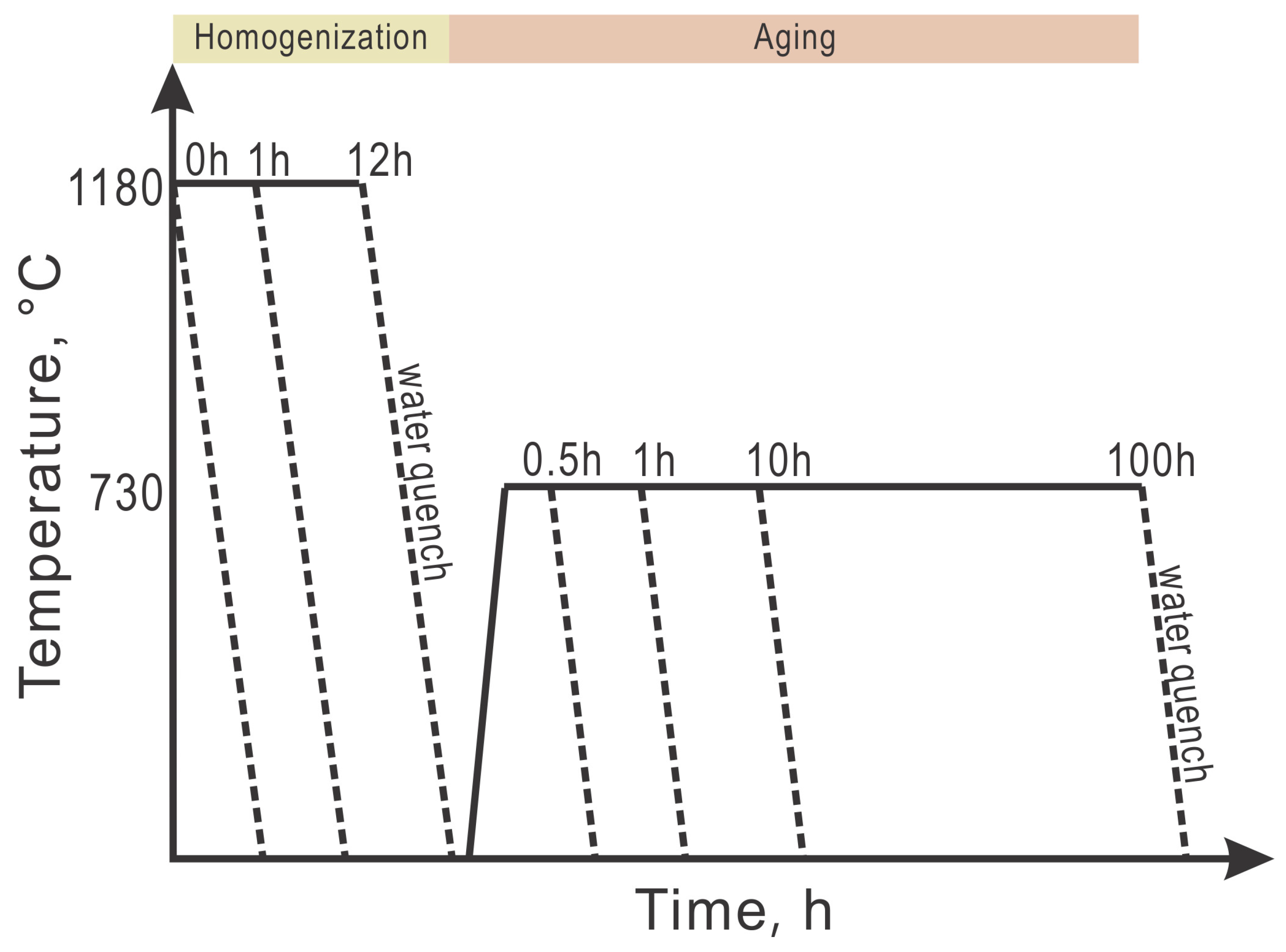


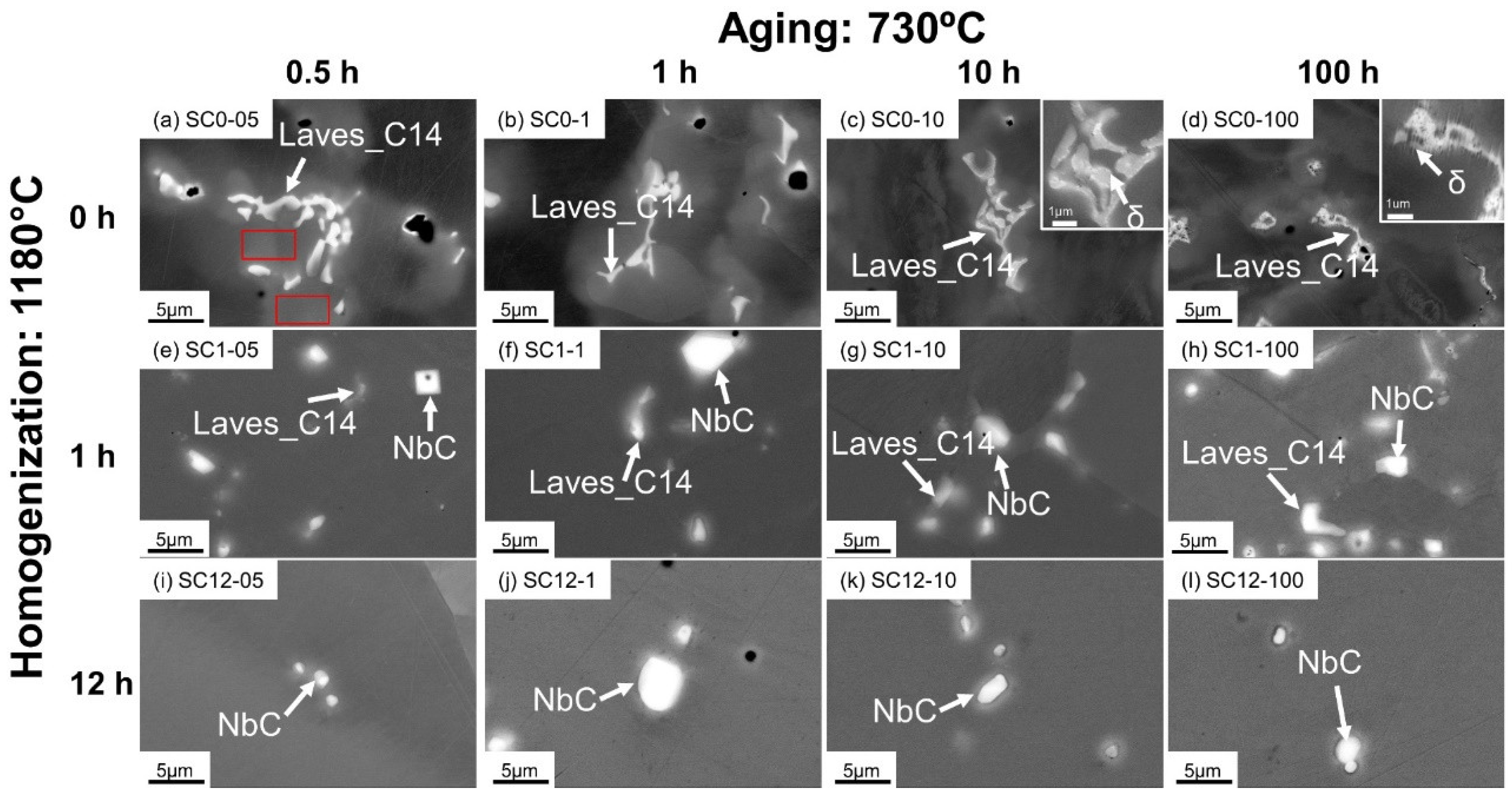
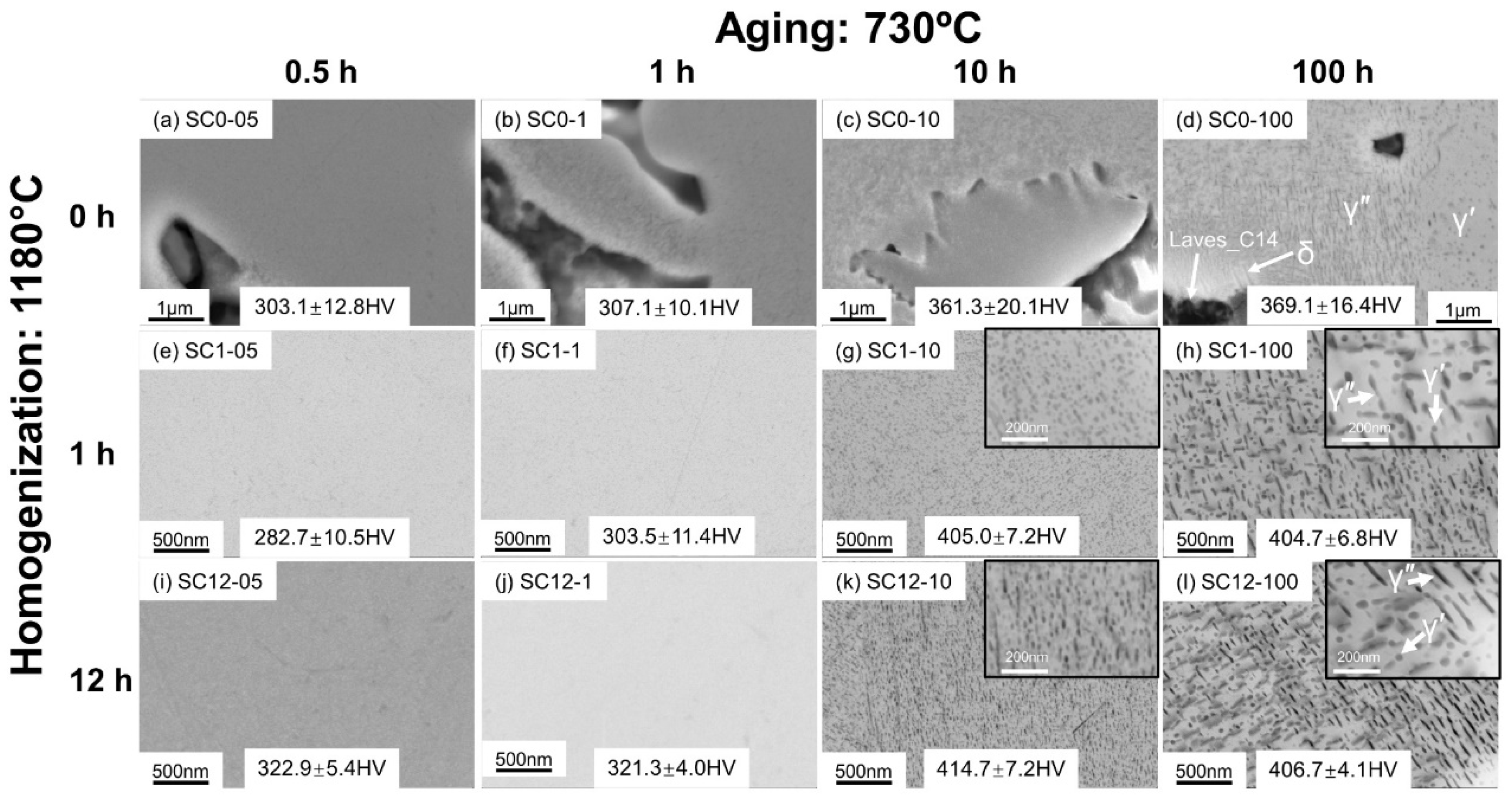
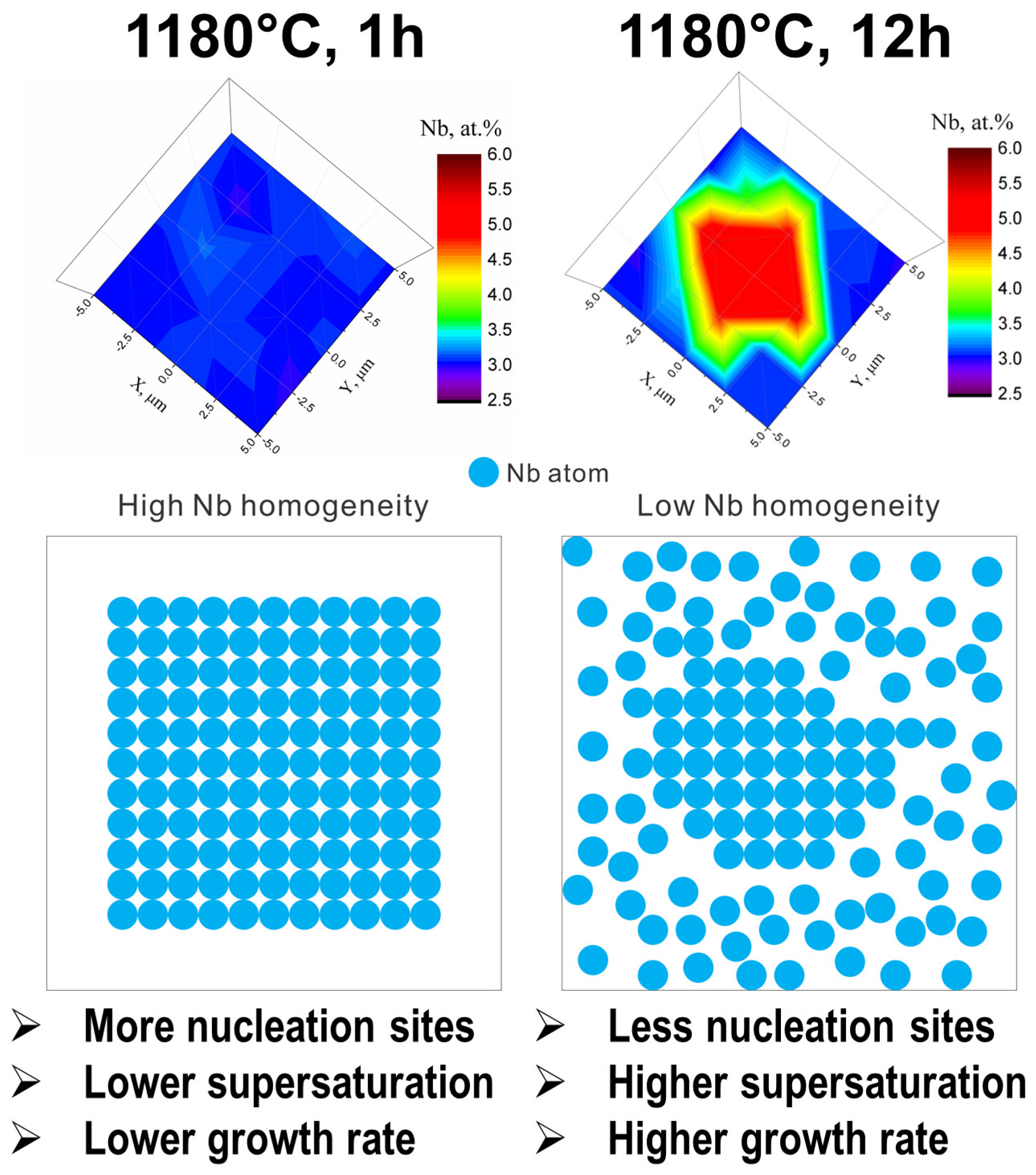
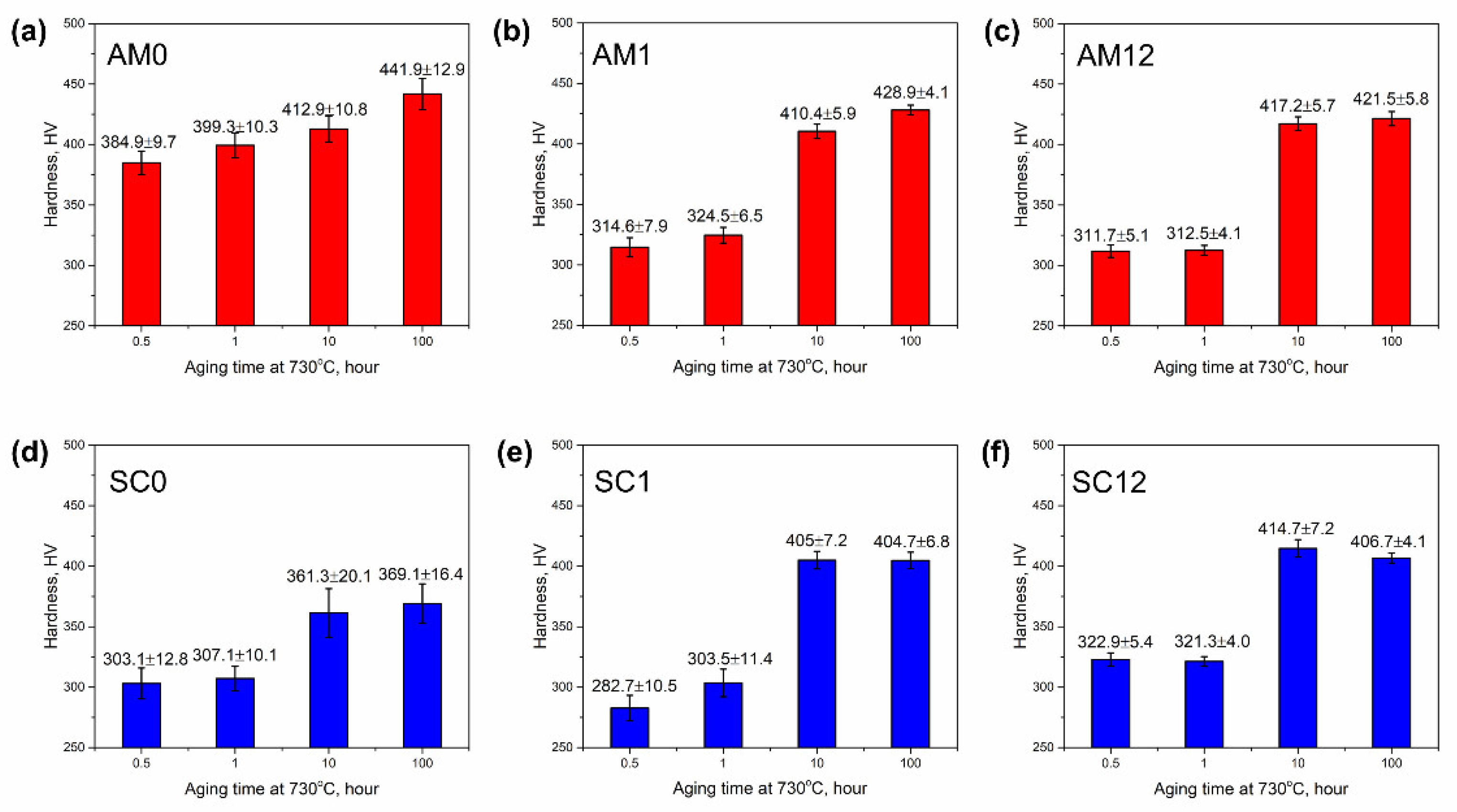
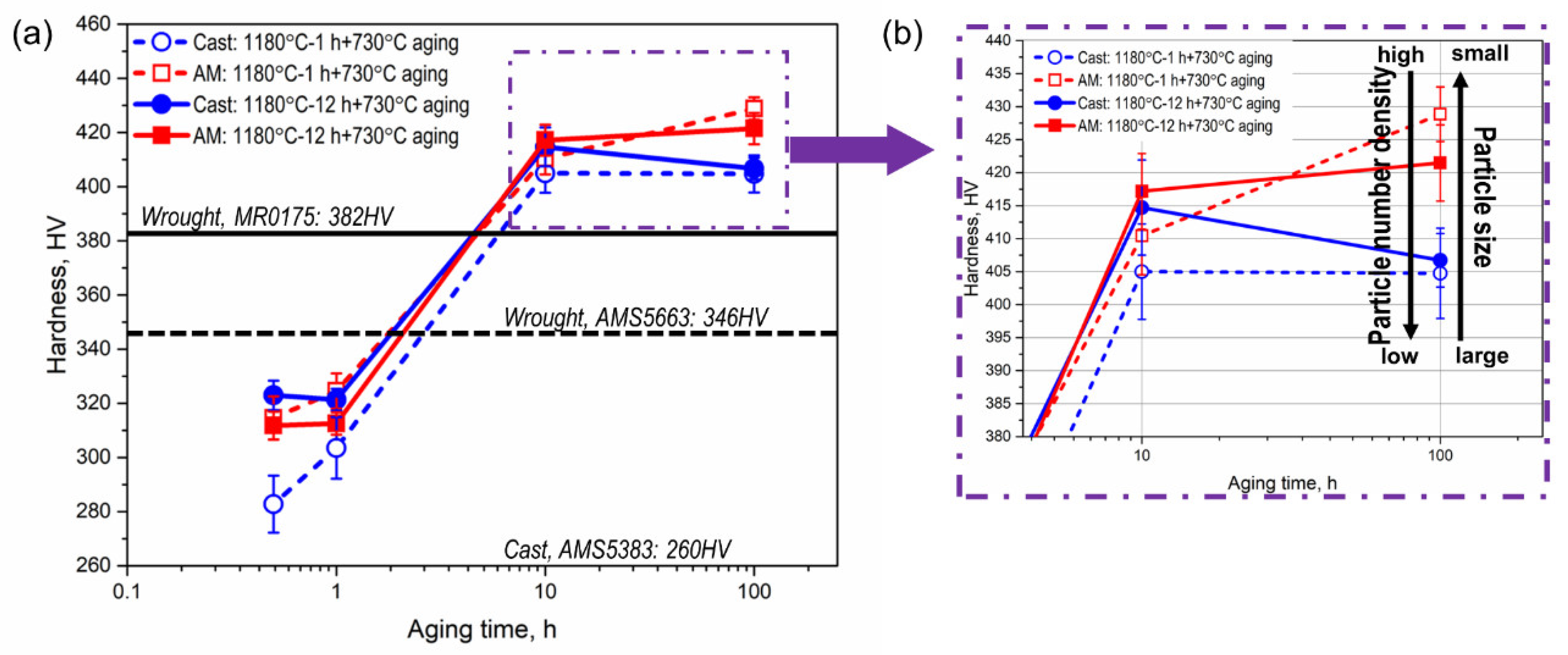
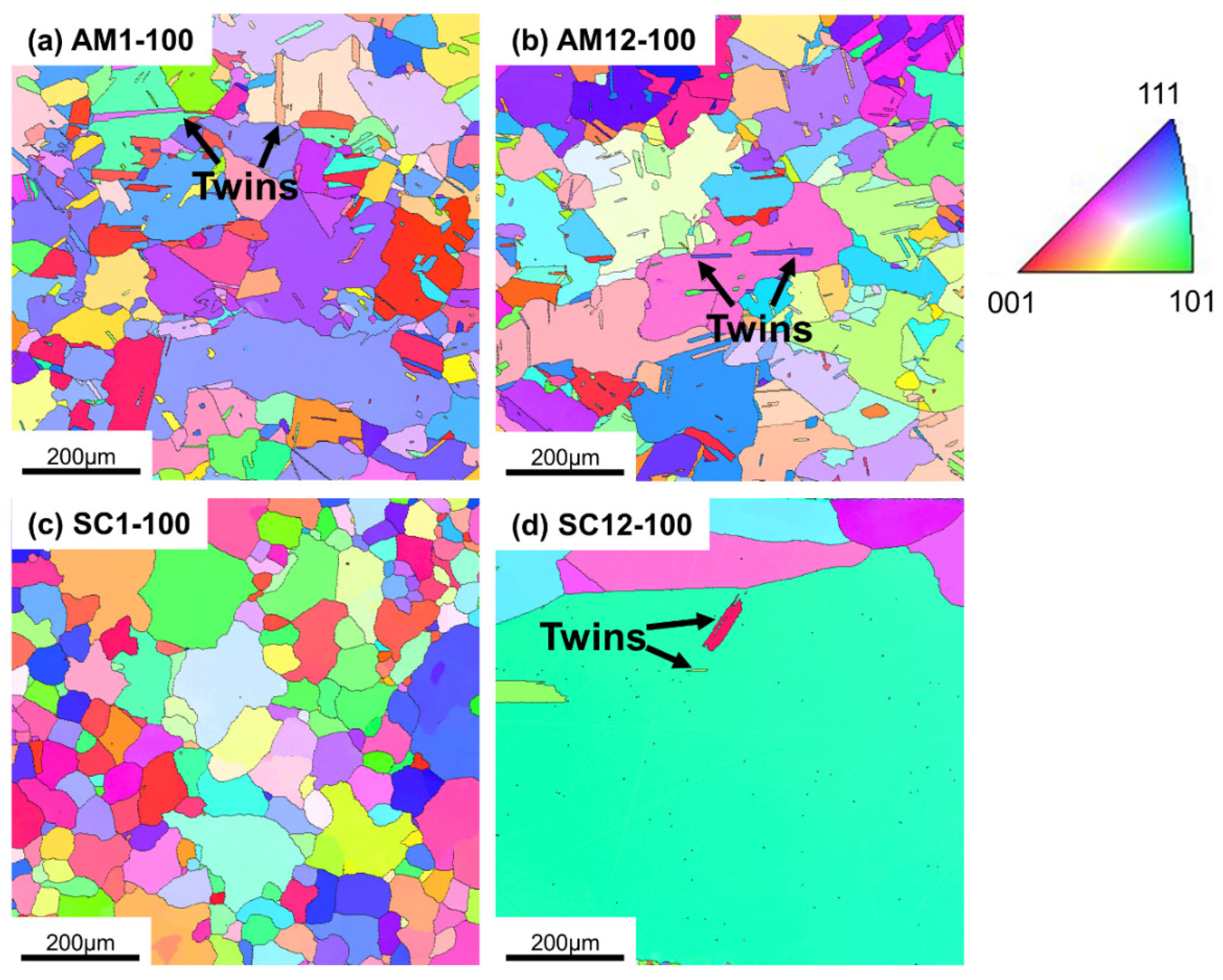
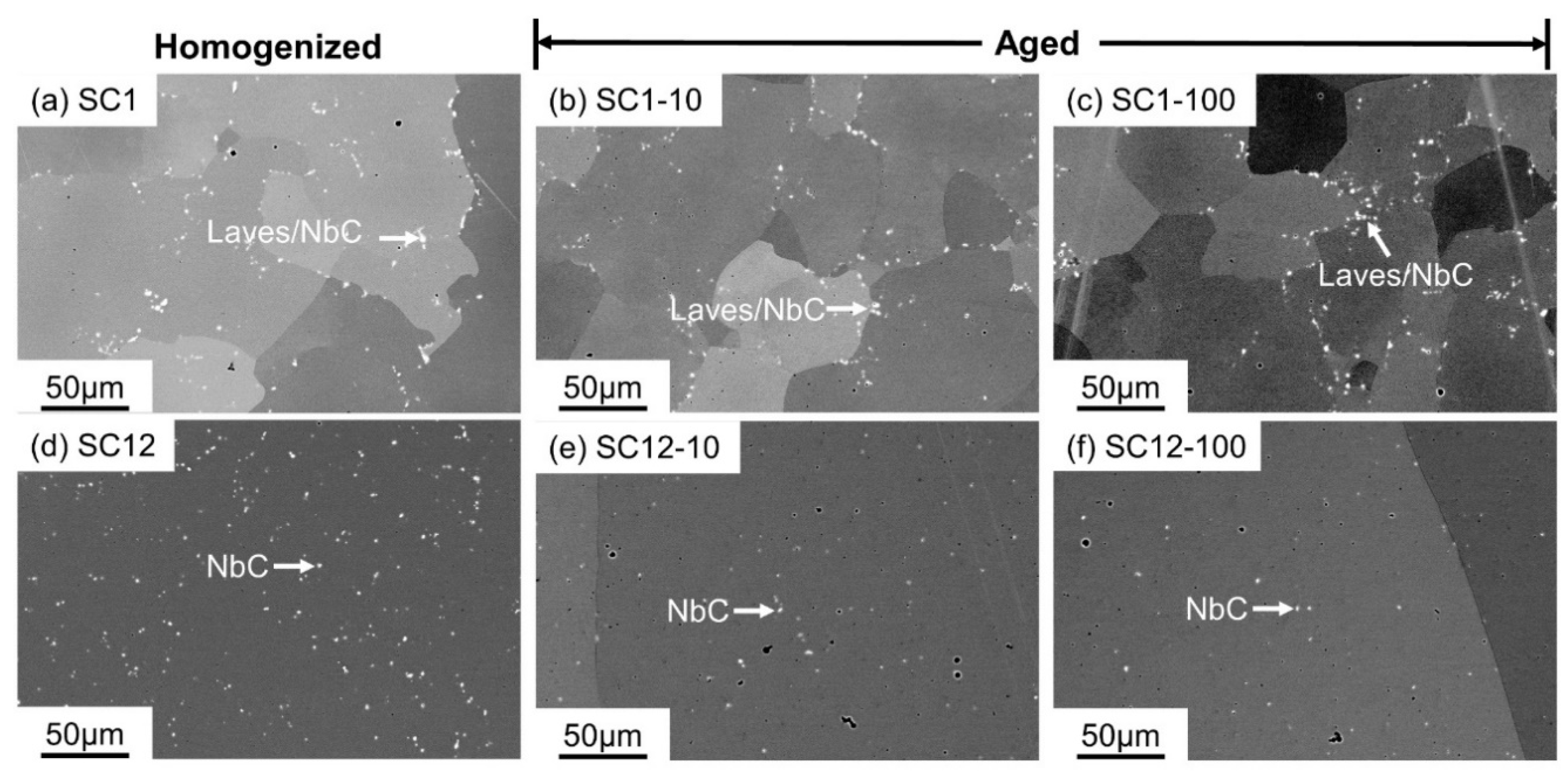
| wt.% | Ni | Fe | Cr | Nb | Mo | Ti | Al |
|---|---|---|---|---|---|---|---|
| SC | Bal. | 18.50 | 18.30 | 4.99 | 3.04 | 1.02 | 0.55 |
| AM | Bal. | 18.26 | 18.87 | 4.97 | 2.97 | 0.94 | 0.46 |
| wt.% | Mn | Co | Cu | Si | C | ||
| SC | 0.23 | 0.39 | 0.07 | 0.08 | 0.051 | ||
| AM | 0.06 | 0.23 | 0.05 | 0.06 | 0.03 |
| AM-PBF-LB/M | Suction Casting | ||||
|---|---|---|---|---|---|
| Sample | Homogenization | Aging time at 730 °C, hour | Sample | Homogenization | Aging time at 730 °C, hour |
| AM0-05 | As-built | 0.5 | SC0-05 | As-cast | 0.5 |
| AM0-1 | 1 | SC0-1 | 1 | ||
| AM0-10 | 10 | SC0-10 | 10 | ||
| AM0-100 | 100 | SC0-100 | 100 | ||
| AM1-05 | 1180 °C for 1 h | 0.5 | SC1-05 | 1180 °C for 1 h | 0.5 |
| AM1-1 | 1 | SC1-1 | 1 | ||
| AM1-10 | 10 | SC1-10 | 10 | ||
| AM1-100 | 100 | SC1-100 | 100 | ||
| AM12-05 | 1180 °C for 12 h | 0.5 | SC12-05 | 1180 °C for 12 h | 0.5 |
| AM12-1 | 1 | SC12-1 | 1 | ||
| AM12-10 | 10 | SC12-10 | 10 | ||
| AM12-100 | 100 | SC12-100 | 100 | ||
| Sample | γ″ Particle Length, nm | γ′ Particle Length, nm | Number Density (γ″ + γ′), /m2 |
|---|---|---|---|
| AM1-100 | 45.39 ± 26.87 | 21.98 ± 11.06 | 2.8 ± 0.29 × 1014 |
| AM12-100 | 51.21 ± 30.83 | 23.95 ± 11.68 | 2.21 ± 0.84 × 1014 |
| SC12-100 | 70.32 ± 42.4 | 34.87 ± 17.57 | 9.65 ± 0.41 × 1013 |
| SC1-100 | 86.68 ± 46.83 | 35.48 ± 16.26 | 9.03 ± 0.86 × 1013 |
| Average Grain Size, μm | AM1-100 | AM12-100 | SC1-100 | SC12-100 |
|---|---|---|---|---|
| Aged sample | 113.4 ± 74.5 | 115.7 ± 62.7 | 100.9 ± 54.9 | - |
| Homogenized sample * | 128.8 ± 75.2 | 113.6 ± 63.6 | 302.9 ± 128.7 | 648.2 ± 292.7 |
Disclaimer/Publisher’s Note: The statements, opinions and data contained in all publications are solely those of the individual author(s) and contributor(s) and not of MDPI and/or the editor(s). MDPI and/or the editor(s) disclaim responsibility for any injury to people or property resulting from any ideas, methods, instructions or products referred to in the content. |
© 2023 by the authors. Licensee MDPI, Basel, Switzerland. This article is an open access article distributed under the terms and conditions of the Creative Commons Attribution (CC BY) license (https://creativecommons.org/licenses/by/4.0/).
Share and Cite
Zhao, Y.; Xiong, W. Influence of Homogenization on Phase Transformations during Isothermal Aging of Inconel 718 Superalloys Fabricated by Additive Manufacturing and Suction Casting. Materials 2023, 16, 4968. https://doi.org/10.3390/ma16144968
Zhao Y, Xiong W. Influence of Homogenization on Phase Transformations during Isothermal Aging of Inconel 718 Superalloys Fabricated by Additive Manufacturing and Suction Casting. Materials. 2023; 16(14):4968. https://doi.org/10.3390/ma16144968
Chicago/Turabian StyleZhao, Yunhao, and Wei Xiong. 2023. "Influence of Homogenization on Phase Transformations during Isothermal Aging of Inconel 718 Superalloys Fabricated by Additive Manufacturing and Suction Casting" Materials 16, no. 14: 4968. https://doi.org/10.3390/ma16144968
APA StyleZhao, Y., & Xiong, W. (2023). Influence of Homogenization on Phase Transformations during Isothermal Aging of Inconel 718 Superalloys Fabricated by Additive Manufacturing and Suction Casting. Materials, 16(14), 4968. https://doi.org/10.3390/ma16144968







